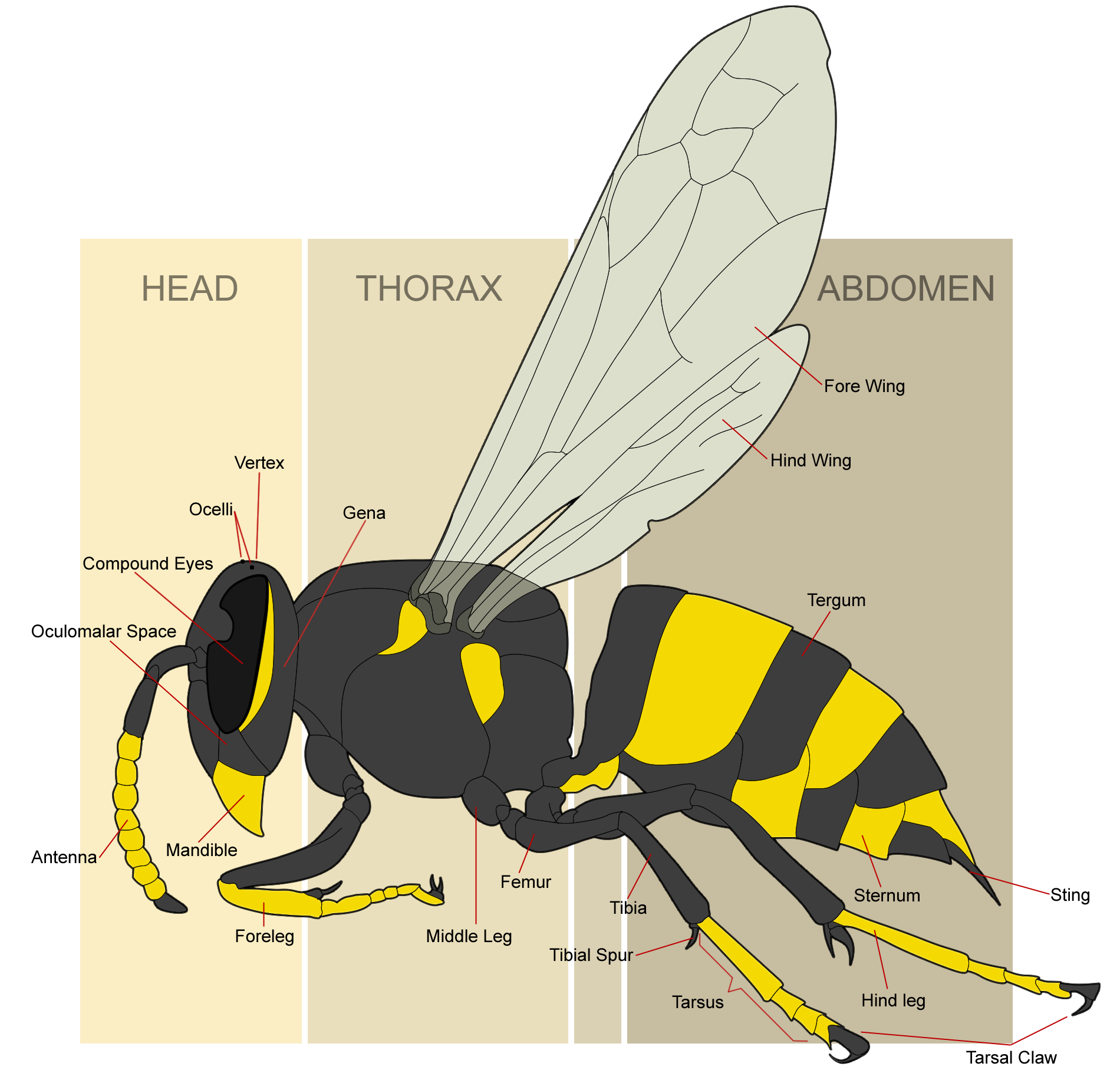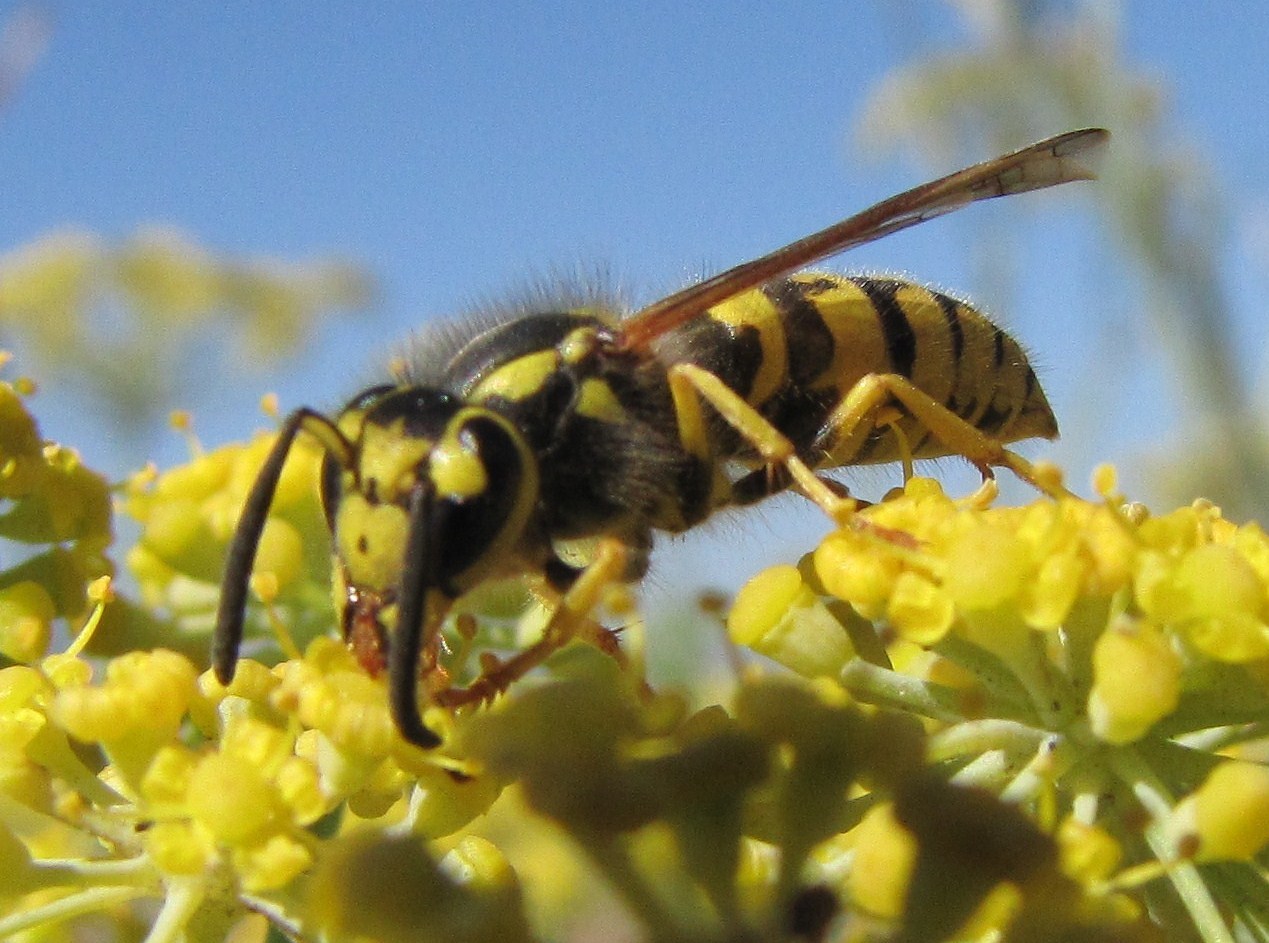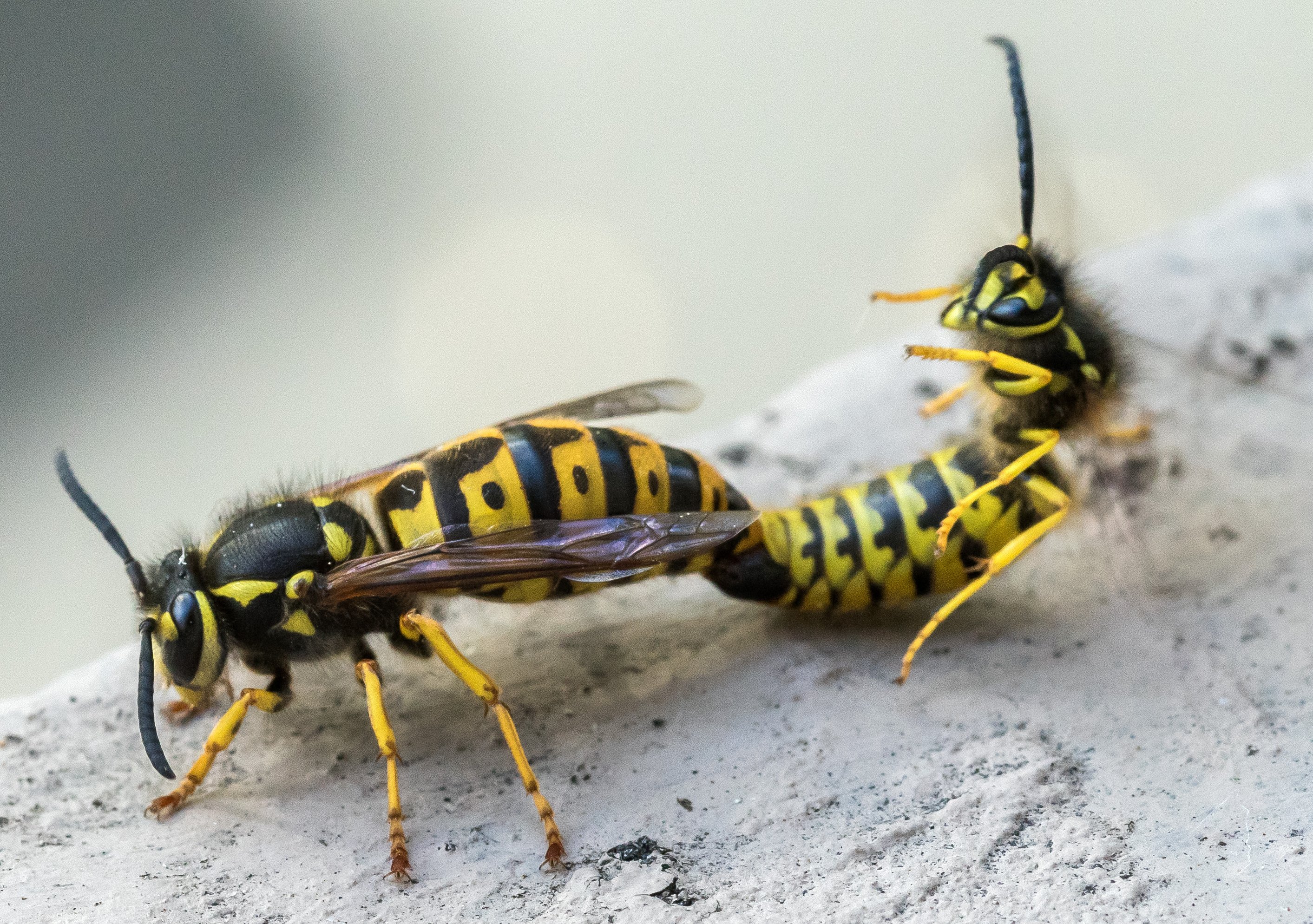|
Vespula 0078 Large
''Vespula'' is a small genus of social wasps, widely distributed in the Northern Hemisphere. Along with members of their sister genus ''Dolichovespula'', they are collectively known by the common name yellowjackets (or yellow jackets) in North America. ''Vespula'' species have a shorter oculomalar space (shown in the figure below right) and a more pronounced tendency to nest underground than ''Dolichovespula''. Notable species * While most species of this genus inhabit North America, four ''Vespula'' species inhabit Europe, namely ''V. austriaca, V. germanica, V. rufa'', and ''V. vulgaris''. * Two common European species, the German wasp (''V. germanica'') and the common wasp (''V. vulgaris''), have established in other countries; both species are now found in New Zealand, Australia, and South America, while the former has also been introduced in South America, and the latter in Southern Africa. * The eastern yellowjacket (''V. maculifrons'') and western yellowjacket ('' V. pe ... [...More Info...] [...Related Items...] OR: [Wikipedia] [Google] [Baidu] |
German Wasp
''Vespula germanica'', known colloquially as the European wasp, German wasp, or German yellowjacket, is a species of wasp found in much of the Northern Hemisphere, native to Europe, Northern Africa, and temperate Asia. It has spread and become well-established in many other places, including North America, South America (Argentina and Chile), Australia, South Africa, and New Zealand. German wasps are part of the family Vespidae and are sometimes mistakenly referred to as paper wasps because they build grey paper nests, although strictly speaking, paper wasps are part of the subfamily Polistinae. In North America, they are also known as yellowjackets. Taxonomy and phylogeny ''Vespula germanica'' belongs to the genus '' Vespula'', which includes various species of social wasps that are found throughout the Northern Hemisphere. In North America, these wasps are most commonly known as yellowjackets, but this name also applies to species within the sister genus '' Dolichovespula'' ... [...More Info...] [...Related Items...] OR: [Wikipedia] [Google] [Baidu] |
Western Yellowjacket
''Vespula pensylvanica'', the western yellowjacket, is a Nearctic species of wasp in the genus ''Vespula''.Akre, Roger D., Albert Greene, John F. MacDonald, Peter J. Landolt, and Harry G. Davis. Agricultural Handbook Number 552. United States Department of Agriculture, 1981. Print. It is native to regions of North America, largely in areas with northern temperate climates. Its reproductive behavior is constrained by cold weather, which successfully reduces the number of western yellowjackets in cold months. However, in the absence of cold weather, this wasp's population can explode. The western yellowjacket has become particularly invasive in the Hawaiian Islands, resulting in their label as a major pest.Wilson, E. E., L. M. Mullen, and D. A. Holway. "Life History Plasticity Magnifies the Ecological Effects of a Social Wasp Invasion." Proceedings of the National Academy of Sciences 106.31 (2009): 12809-2813. Web. Taxonomy and phylogeny ''V. pensylvanica'' was originally named by H ... [...More Info...] [...Related Items...] OR: [Wikipedia] [Google] [Baidu] |
Vespula Infernalis
''Vespula infernalis'' is an obligate parasitic wasp, parasitizing the nests of other species in the genus ''Vespula''. Its common host species is '' V. acadica'' in North America. It is sometimes called the cuckoo yellowjacket wasp due to its inquiline lifestyle. They differ from other parasitic wasps in their intensely aggressive behaviour during invasion and occupation of the host colony. Several morphological adaptations such as bigger body parts and highly curved stingers are present in these wasps to aid their aggressive parasitic behaviour. Once they occupy a host's nest, ''V. infernalis'' are known to engage in mauling and chasing of host workers and forced trophallaxis. Female wasps will also force host workers to feed and take care of their brood . Taxonomy and phylogeny ''V. infernalis'' is a member of the family Vespidae. It is nearly identical in appearance and biology to the Old World species '' V. austriaca'' and is considered its sister species. Until recentl ... [...More Info...] [...Related Items...] OR: [Wikipedia] [Google] [Baidu] |
Vespula Inexspectata
''Vespula inexspectata'', the volcano yellowjacket, is a species of wasp in the family Vespidae. It was described by Regine Eck in 1994. The species is endemic to Mexico. The holotype was collected on the west slope of Popocatépetl Popocatépetl ( , , ; ) is an active stratovolcano located in the states of Puebla, Morelos, and Mexico in central Mexico. It lies in the eastern half of the Trans-Mexican Volcanic Belt. At it is the second highest peak in Mexico, after Ci .... References Insects described in 1994 Vespidae Endemic insects of Mexico Taxa named by Regine Eck {{Vespidae-stub ... [...More Info...] [...Related Items...] OR: [Wikipedia] [Google] [Baidu] |
Vespula Germanica
''Vespula germanica'', known colloquially as the European wasp, German wasp, or German yellowjacket, is a species of wasp found in much of the Northern Hemisphere, native to Europe, Northern Africa, and temperate Asia. It has spread and become well-established in many other places, including North America, South America (Argentina and Chile), Australia, South Africa, and New Zealand. German wasps are part of the family Vespidae and are sometimes mistakenly referred to as paper wasps because they build grey paper nests, although strictly speaking, paper wasps are part of the subfamily Polistinae. In North America, they are also known as yellowjackets. Taxonomy and phylogeny ''Vespula germanica'' belongs to the genus ''Vespula'', which includes various species of social wasps that are found throughout the Northern Hemisphere. In North America, these wasps are most commonly known as Yellow jacket, yellowjackets, but this name also applies to species within the sister genus ''Dolic ... [...More Info...] [...Related Items...] OR: [Wikipedia] [Google] [Baidu] |
Vespula Flavopilosa
''Vespula flavopilosa'', also known as the downy yellowjacket, is a species of yellowjacket Yellowjacket or yellowjacket is the common name in North America for predatory social wasps of the genus, genera ''Vespula'' and ''Dolichovespula''. Members of these genera are known simply as "wasps" in other English-speaking countries. Most of ... found in North America. References Further reading * Vespidae {{vespidae-stub ... [...More Info...] [...Related Items...] OR: [Wikipedia] [Google] [Baidu] |
Vespula Flaviceps
''Vespula flaviceps'' is a species of social wasp in the genus ''Vespula''. It found in Eastern Asia and Japan. Studies have suggested that the queens of this species may mate with more males and use sperm more evenly. The reason for this is not yet well understood. Taxonomy Synonyms ''V. flaviceps'' has been described by various other binomial names. A list of such names is presented below: *''Vespa flavior'' *''Vespa japonica'' *''Vespa karenkona'' *''Vespa lewisii'' *''Vespa quadrimaculata'' *''Vespa saussurei'' *''Vespula gracilia'' *''Vespula pionganensis'' *''Vespula yulongensis'' Subspecies ''V. flaviceps'' has two subspecies. They are ''V. f. flaviceps'' and ''V. f. lewisii''. Distribution and habitat ''V. flaviceps'' is native to Eastern Asia and Japan. It can be found most prominently on the Japanese Islands, but is also present in South Korea and the southern portion of Primorsky Krai. Its population may be threatened by introduced species, invasive raccoon ... [...More Info...] [...Related Items...] OR: [Wikipedia] [Google] [Baidu] |
Vespula Consobrina
''Vespula consobrina'', commonly known as the blackjacket (not to be confused with ''Dolichovespula maculata'', which is also called “blackjacket”), is a species of stinging wasp in the family Vespidae The Vespidae are a large (nearly 5000 species), diverse, cosmopolitan family of wasps, including nearly all the known eusocial wasps (such as '' Polistes fuscatus'', '' Vespa orientalis'', and ''Vespula germanica'') and many solitary wasps. Eac ..., which includes multiple cousin species in the northern hemisphere, such as the German yellowjacket and other social wasps. Appearance Queen blackjackets are 17mm in size, while female workers are 10-12mm and males 15-16mm. Blackjacket wasps can easily be identified in the wild by their distinct black and white striped pattern on their abdomen and the white and black coloration. Habitat and distribution Blackjackets can be found in all of Canada except Nunavut and in the northern states of the United States. They usually build ... [...More Info...] [...Related Items...] OR: [Wikipedia] [Google] [Baidu] |
Vespula Austriaca
''Vespula austriaca'' is an obligate parasitic wasp, parasitizing the nests of other species in the genus '' Vespula'' in the Old World. Its common host species include '' V. rufa'' in Europe, Japan, and East Siberia.''V. austriaca ''wasps pollinate orchids. In some literature, ''V. austriaca'' is mentioned under the common name "Cuckoo wasp", but this should not be confused with the family Chrysididae, which have the same common name. Taxonomy and phylogeny ''Vespula austriaca'' is a member of the family Vespidae. The genera '' Vespula'' and '' Dolichovespula'' are thought to be closely related and are considered sister groups. Their similarities include absences of strong seta on third segment of labial palpus, smaller scutal lamella, and a characteristic twisted pedicel in embryonic nests. The Nearctic population formerly considered as belonging to ''V. austriaca'' has been recognized as a separate species, '' Vespula infernalis''. Description and identification ''Ves ... [...More Info...] [...Related Items...] OR: [Wikipedia] [Google] [Baidu] |
Vespula Atropilosa
''Vespula atropilosa'', also known as the prairie yellowjacket, is a black and yellow social insect, social wasp that forms annual colony (biology), colonies. ''Vespula atropilosa'' was formerly a member of the ''Vespa (genus), Vespa'' family. Males have either xanthic (yellow) or melanic (black) abdominal coloring. The prairie yellowjacket can be found in the Western United States, Western and Midwestern United States as well as parts of southern Canada. It builds its nests underground and prefers large open areas such as pastures and golf courses. ''Vespula atropilosa'' colonies are founded by a queen in the spring and grow most during mid-summer. It preys on other insects such as flies and grasshoppers but is not a scavenger like other wasps. Queens mate with multiple males, and males will fight each other for matings. ''V. atropilosa'' is a social wasp that practices altruism (biology), altruism. Prairie yellowjackets are not considered pests but are commonly found in backyards ... [...More Info...] [...Related Items...] OR: [Wikipedia] [Google] [Baidu] |
Vespula Arisana
''Vespula arisana'', also known as the Taiwan yellowjacket, and Taiwan hornet, is a species of wasp in the family Vespidae. It was described by Jinhaku Sonan in 1929. The species is endemic Endemism is the state of a species being found only in a single defined geographic location, such as an island, state, nation, country or other defined zone; organisms that are indigenous to a place are not endemic to it if they are also foun ... to the island of Taiwan, where its range covers the entire island. Not much is known about the species, because of its exclusivity and endemicity. References {{Taxonbar, from=Q14424040 Vespidae ... [...More Info...] [...Related Items...] OR: [Wikipedia] [Google] [Baidu] |
Vespula Alascensis
''Vespula alascensis'', also referred to as common yellowjacket, is a species of yellowjacket that inhabits North America. Although it was named in 1870, it was, until 2010, treated as a taxonomic synonym of a related species, ''Vespula vulgaris'', but is now recognized as a distinct taxon In biology, a taxon (back-formation from ''taxonomy''; : taxa) is a group of one or more populations of an organism or organisms seen by taxonomists to form a unit. Although neither is required, a taxon is usually known by a particular name and .... Generally it nests in the ground. References Bugguide.net. Species ''Vespula alascensis''* External links * Vespidae Insects described in 1870 Taxa named by Alpheus Spring Packard {{Vespidae-stub ... [...More Info...] [...Related Items...] OR: [Wikipedia] [Google] [Baidu] |






